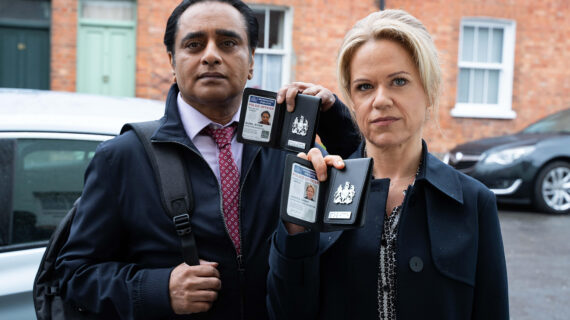Announcer:
The following program is a PBS Wisconsin original production.
Frederica Freyberg:
Excessive prolonged heat and little rain reaches natural disaster proportions. Extreme heat also leads to more deaths than any other weather-related events. I’m Frederica Freyberg, tonight on “Here & Now,” the Farm Bureau on the effects of severe drought conditions. Plus, a climate and health expert on staying safe in excessive heat. The feds raise interest rates again. How is the Wisconsin economy faring? And an agency report on restraints used on students with disabilities. It’s “Here & Now” for July 28.
Announcer:
Funding for ” Here & Now ” is provided by the Focus Fund for Journalism and Friends of PBS Wisconsin.
Frederica Freyberg:
At the mercy of Mother Nature, farmers without any sort of irrigation are being left high and dry, but some relief is in sight. The US Department of Agriculture declared 27 Wisconsin counties are under a natural disaster designation due to the extended and severe drought conditions. The designation opens up resources to farmers within those counties, including emergency loans. For more on how Wisconsin farmers are faring, we turn to Kevin Krentz, president of the Wisconsin Farm Bureau Federation. Thanks very much for being here.
Kevin Krentz:
Thank you. Thank you for having me today.
Frederica Freyberg:
So for farmers in counties designated as in extreme drought, is this a total bust for crops at this point?
Kevin Krentz:
No, not necessarily, but there’s definitely a huge amount of stress out there on those crops beginning in early May. This drought really started in early to mid-May, and some of those seeds really had trouble even germinating and coming out of the ground, and that’s affecting the whole growing season, and we have inconsistencies when we’re going through pollination right now, and that’s going to affect yield a great deal.
Frederica Freyberg:
So how would you describe the condition of the corn, soybean and oat crops?
Kevin Krentz:
It’s extremely variable, and I would throw wheat in there as well. A lot of our vegetables are in the Central Sands region. Many of that has the opportunity to be irrigated, but there is some dry land as well, so the vegetables are also part of this, but on the row crop side of it, the corn, the soybeans, the wheat, there’s a lot of inconsistencies across the state. There’s some areas that received timely rains. Maybe not as much as they probably could have, but they received timely rains that really were able to capture some of that and be able to be a decent yield, at least in the wheat crop so far, but there’s many parts of the state that are really struggling.
Frederica Freyberg:
Yeah, for sure. Do most farmers have crop insurance? And does that cover all losses?
Kevin Krentz:
So the crop insurance — yeah, there’s many farmers that do have crop insurance, but it’s expensive to buy to a certain level. So most farmers will cover 65 to 70% of their crop, maybe up to 80%, but when you’re talking about the livestock industry here in Wisconsin, we’ve got to have feed for the cows, so it’s not only being able to sell that crop, it’s being able to have enough feed for your animals at the end of the day.
Frederica Freyberg:
So what are the concerns around that right now?
Kevin Krentz:
Well, again, it comes back to if you can’t raise it, then you have to purchase it, and if this drought is widespread enough, those crops have to be trucked in a longer distance. Now, we do — we are fortunate here in the upper Midwest that the majority of our grains are grown right here in the Midwest, so there should be plenty of grain to feed our livestock. It’s just a matter of some farms won’t be able to produce enough themselves to feed their own livestock so they’ll have to purchase some of that.
Frederica Freyberg:
What does the federal disaster declaration do for farmers in bad straits right now?
Kevin Krentz:
So it gives the ability for some low-cost loans, again, to purchase feed, to be able to cover some of those inputs that we had on planting the crop to begin with, so it covers some of those losses.
Frederica Freyberg:
Will provisions in the state budget for increased funding for crop insurance to include things like help with premiums help off-set costs for producers at all?
Kevin Krentz:
So maintaining — we’re in the midst of a Farm Bill discussion on a federal level and the crop insurance program is part of that, and maintaining a robust crop insurance program is good for everybody. It’s good for farmers to be able to protect their crop, but it’s also good for consumers because essentially that’s feed and food that comes back to us as consumers, and so it’s a food security program as well.
Frederica Freyberg:
So given all that, how important are our major crops to our state’s economy?
Kevin Krentz:
Oh, extremely important. When you’re talking the vegetable side of things, we’re number two in potatoes, number one in cranberries, but corn and soybeans, again, go to feed a lot of our livestock industry. We’re number two in the dairy industry in the nation. Right up there with the beef industry as well. So it’s extremely important for Wisconsin’s economy. We’re $105 billion industry in Wisconsin, and — but the key part of being such a large economic driver is farms support local communities across the state, and when farms struggle, local communities struggle, because even a number of years ago, I did the research on my own farm and found that 62% of my expenses are spent within a 15-mile radius of my farm. So you multiply that by the 60 plus thousand farms across the state and it’s a huge impact on local communities all across.
Frederica Freyberg:
All right. Kevin Krentz, thanks very much.
Kevin Krentz:
Thank you.
Frederica Freyberg:
Farmers looking for more information during this critical time can visit the drought resources page from the state Department of Agriculture, Trade and Consumer Protection.
As to weather conditions, extreme heat is a definite hazard to vulnerable populations, including now here in Wisconsin. Across the southern part of the state this week, heat advisories went out with feels-like temperatures topping 100 degrees. Add to that, air quality alerts and it’s not only miserable, it can be dangerous. We turn to Margaret Thelen, the climate and health program manager in the DHS Bureau of Environmental and Occupational Health. Thanks very much for being here.
Margaret Thelen:
Thank you.
Frederica Freyberg:
So with heat indices over 100 degrees in southern Wisconsin as we’ve said, how really dangerous can this be?
Margaret Thelen:
It’s very dangerous, and it’s just becoming more and more common with climate change right now and it’s dangerous to everybody. The Wisconsin Initiative on Climate Change Impacts projected that even some areas of the state are going to experience almost a month more of 90-degree days by midcentury. So by 2050.
Frederica Freyberg:
How at risk are people who have to work outdoors or vulnerable populations like the unhoused, elderly, or people with disabilities?
Margaret Thelen:
Yeah. It’s important to remember that extreme heat can impact anybody. But like you said, those — the unhoused population, older adults, young children, they are more likely to experience those kind of symptoms. For outdoor workers, it’s really important that those supervisors and employers review their policies and procedures on a climatization or put in different — or letting the workers work at different priorities or find more water and shade during those times.
Frederica Freyberg:
Is that happening to your knowledge?
Margaret Thelen:
It does. There are OSHA policies that a lot of employers use to be able to help their employees.
Frederica Freyberg:
How real are the dangers of first, heat exhaustion and then heatstroke?
Margaret Thelen:
Oh, they’re very real. Heat-related illnesses range from heat rash, which is the splotchy red and the itching, to heat cramps to heat exhaustion and finally heatstroke. Heatstroke can really happen within minutes and it’s really important that you recognize those signs and symptoms in your friends, your family, those around you, and even in yourself.
Frederica Freyberg:
How do you know if you’re really in trouble with those things?
Margaret Thelen:
Yeah. So with heatstroke and heat exhaustion, you become really dizzy. You become confused. You start rapidly breathing. It really turns dangerous when your internal body temperature is above 104 degrees, and when that happens, you need to be able to immediately find shade or find a cool area, be able to drink water. I know when I get really warm after a run, I like to put a bag of ice on the back of my neck because that just cools you down immediately.
Frederica Freyberg:
Is it safe to be even indoors without air conditioning right now?
Margaret Thelen:
There’s a lot of different factors that go into cooling a house. The cooler areas where there’s less direct sunlight like basements or cellars are generally cooler. You can be in there. But when we’re reaching these high temperatures, and a lot of people will put fans on, and if they don’t have air conditioning, fans actually aren’t recommended when it’s above 95 degrees because it doesn’t allow your body to cool. It will actually heat your body up with that air movement.
Frederica Freyberg:
So with all of that said, are there enough of these public cooling centers available?
Margaret Thelen:
So each of the local municipalities will identify those public areas where people can go. Often they’ll work with 211 so that people have a single spot to call to be able to find either transportation or find those locations. So think libraries, churches, community centers, those areas are usually available.
Frederica Freyberg:
We know that the Biden administration has just announced a new hazard alert system and stepped up inspections and enforcement of high-risk industries like construction. What kind of changing responses do public agencies like yours at DHS have considering this kind of extreme heat?
Margaret Thelen:
I work for the climate and health program and we like to work a lot with other state agencies and federal agencies like the National Weather Service to be able to communicate and prepare for extreme heat. So finding ways to reach those populations that are needed. We also work a lot with local health departments, local emergency management to provide data and best practices as they implement these extreme heat-related response plans that they have so that people can find the cooling centers, they can meet those unmet needs faster.
Frederica Freyberg:
Because presumably we can count on more of this going forward?
Margaret Thelen:
Yeah, with climate change, Wisconsin is becoming warmer and wetter and we want to be able to empower our local decision makers, our local public officials with that data and knowledge to be able to respond quickly to these type of events.
Frederica Freyberg:
All right. Margaret Thelen, thanks very much.
Margaret Thelen:
Thank you.
Frederica Freyberg:
In economic news, non-farm jobs in Wisconsin grew to a record high three million plus in June. Inflation has fallen but remains stubbornly above targets. The fed just raised interest rates another quarter point hoping to make borrowing and investing more expensive to reduce demand for goods, services, and labor. Where does all this leave us here in Wisconsin? We turn to Kevin Bahr, UW-Stevens Point emeritus professor at the Century School of Business and Economics. Professor, thank you for being here.
Kevin Bahr:
Frederica, nice to be back. Thanks for having me.
Frederica Freyberg:
All in all, how is the economy for folks in Wisconsin?
Kevin Bahr:
Wisconsin is pretty much tracking the United States in general and the economy has really been doing quite well, much better than expected. The stock market, which is generally viewed as a leading economic indicator, the S&P 500, a benchmark index of large company stocks, that fell by 19% in 2022. That is up about 19% through seven months this year. Tech stocks declined by 33% last year. They’re up about 33% this year. And the reason why everything has gone much better than expected is because economic growth through the first half has been above 2%. That’s viewed as moderate economic growth. There were recessionary concerns at the end of last year. That hasn’t materialized. The labor market in the United States, we have 156 million Americans working. That’s greater than at any other point in time in the history of the United States. It’s five million more than were employed in 2019. It’s 25 million more than were employed at the bottom of 2020 during the COVID years. Unemployment, 3.6%. Everything is very strong, continues to be very strong. If you look at the number of job openings per unemployed worker, that’s about 1.5. So on balance, things have been going very good. Inflation, a year ago, 9%. Now it’s 3%.
Frederica Freyberg:
Those rate hikes really did the trick, though they continue to impose themselves. Unemployment in Wisconsin is about 2-1/2% right now. It’s still a good time to get a job and people should expect the pay to be higher?
Kevin Bahr:
Wage growth has been — wage growth in the last two years has been higher than at any other point this century in the United States. Wage growth has been coming down the last couple of months, but the good news is, the wage growth has been coming down the last couple of months, inflation has been coming down. Now you have wage growth exceeding inflation. So your purchasing power has actually been going up. If I might point out, one of the main reasons why inflation has gone from 9% to 3%, there were global economic factors that really drove inflation throughout the world. Inflation peaked not over 10% in the United Kingdom, in the European Union. It was over 8% in Canada. It was nearly 9% in Mexico, so you had this global inflation last year and the trends, kind of the ups and downs of inflation, the U.S. pretty much reflects that and it was really pretty much driven by yet a nearly doubling of oil prices because Putin invaded Ukraine. You had wheat prices explode by about 50% because Russia and Ukraine combine for about 30% of global wheat exports. Russia is the number one provider of agricultural fertilizer exports, so all that contributed to this huge historically high inflation around the world. So you still have the Federal Reserve raising interest rates and central banks around the world raising interest rates because that’s really all they can do. They’re trying to cut down demand for products, although consumer spending has remained strong, because their goal is to get inflation down to about 2%. Well, we’re still above that so you have another rate increase yesterday, basically 11 rate increases since the beginning of 2022.
Frederica Freyberg:
So I wanted to ask you about the job market. It’s still the case that there is a shortage of workers, and one economic expert I read said that the labor market is, “out of whack.” How does it get realigned?
Kevin Bahr:
Well, that’s what the — you know, that is an excellent question, because I think in my opinion, anyway, if you look at the Federal Reserve and the number one thing that they’re trying to do is to get that labor market back in line. So in other words, where you don’t have this higher number of job openings per unemployed worker. That creates wages going up. That can contribute to inflation. So by increasing interest rates, the idea is that at some point, consumers stop spending on stuff because cost of financing is going to be more expensive. Business investment, residential investment, that’s a little bit up and down over the last year. That’s definitely felt the impacts of the increase in the interest rates, but consumer spending overall has not. But you hit on the exact point, that is why the Federal Reserve keeps on ratcheting up interest rates, even though inflation has come down rather significantly.
Frederica Freyberg:
Well, it is a complicated mix. So, Kevin Bahr of Stevens Point, thanks very much.
Kevin Bahr:
Thanks for having me.
Frederica Freyberg:
In Milwaukee this week, the county board approved a .4% sales tax to shore up its budget and prevent deep cuts to services, this vote follows one earlier this month in the city of Milwaukee that raises the sales tax there by 2%.
In education news, widespread restraint and seclusion practices in schools are disproportionately used in elementary grades and on students with disabilities. That’s according to a recent report from the Department of Public Instruction, which called the rates concerningly high with some 5900 incidents of seclusion and 6900 of restraint. A 2019 law required DPI to start collecting data on use of these practices and limit their use. Physical restraint is defined as a restriction that immobilizes or reduces the ability of a student to freely move their torso, arms, legs, or head. It may only be used when a student’s behavior presents a clear, present, and imminent risk to the physical safety of the student or others. Seclusion means the involuntary confinement of a student apart from other students in a room or area from which the student is physically prevented from leaving. DPI says the use of these practices must be a last resort. For reaction to the widespread use of these practices, we sat down with Madison civil rights attorney Jeff Spitzer-Resnick. Having been a chief advocate for laws restricting seclusion and restraint in schools, what’s your reaction to the latest DPI reporting that there are these thousands of incidents in the 2021/2022 school year?
Jeff Spitzer-Resnick:
Well, there’s a few reactions. The first reaction is, wow, that’s a lot of kids who are suffering from, really, an abhorrent behavior on adults’ part, being secluded, restrained. I would ask any adult to imagine themselves being held against their will and being put into a room that where no one else is, how they would feel. But second, when we look at the numbers, we see that it’s a huge percentage, almost all of them are in elementary school. So we have these young children. Now, you might ask me why are they young children? As children grow older, staff just aren’t going to — they’re just not going to try that with a bigger kid. So this power imbalance is really problematic. It’s like we can so called get away with it with young children. Let’s assume for the moment that the ones that are reporting that they have few if any kids who they’re secluding and restraining, why aren’t we not only celebrating that, but DPI finding out, well, how are you doing that? Can you help us train these other schools that are struggling? Conversely, if you have what I’ll call repeat performers, and we generally do, it’s usually not an aberration that a school district has lots of seclusion and restraint and then none the next year. They’re going to stay up there with their numbers. They might go and up down a little bit. What are we doing to change that? If you look at DPI’s report, it simply says at the bottom it lists a few links of resources. Seriously? Is that it? We’ve got to do better than that.
Frederica Freyberg:
So you describe accurately how the numbers suggest that as many as 80% of the children who are restrained or secluded are in grade school. Same holds true for the number of students who are disabled.
Jeff Spitzer-Resnick:
Right. You know, look. You’ve got two things going on with children with disabilities. One is they’re simply more vulnerable, and so therefore they are more subject not only in school but outside of school to be abused, so that’s a problem. I consider this abuse, by the way. Secondly, are there some of those children that may have more challenging behaviors? Of course there are. That’s why they’re in special education. That’s why we have programs and funding, perhaps insufficient. I won’t even say perhaps insufficient, definitely insufficient, to help them. They shouldn’t be on the butt end of trauma, and that’s what seclusion and restraint will do.
Frederica Freyberg:
Do you think there is any place in the schools for seclusion and restraint?
Jeff Spitzer-Resnick:
So what the law says, and what I believe is true is if there’s an imminent risk, and imminent means imminent, like right now, of serious bodily injury, and I emphasize serious, then yes, of course. People ask – I remember when we were trying to get the bill passed, well, wouldn’t you stop a kid who was running into a street in front of a car? Of course we’d stop them. And of course we’d restrain them, temporarily, for a short time. You let them go after the car goes by and you redirect them away.
Frederica Freyberg:
Clearly you don’t think those are the only times that this is being used.
Jeff Spitzer-Resnick:
Of course not, which also then begs the question, is DPI actually examining, and, of course, they can’t examine — they don’t have the staff to examine thousands but could they go into the top or bottom, depending on your view, the three school districts that are showing the highest propensity of seclusion and restraint and actually look and see, are every one of these students who have been secluded and restrained, having done so when there was an imminent risk of harm? I’m a 100% sure they will find not. Then what do we do? The problem is DPI has historically and now presently been complaint responsive. So, yes, if someone files a complaint, if a parent says my kid was secluded and restrained and there was no imminent risk of harm, DPI will look into it, may order a corrective action plan if they substantiate that. But without that complaint, DPI is just going to say, here’s the numbers, here’s some resources, and it’s just inadequate.
Frederica Freyberg:
How do these techniques potentially harm children?
Jeff Spitzer-Resnick:
Well, it can be very traumatizing, ranging from, you know, short-term trauma where a child goes home crying to their mother or father or whatever to what can be, especially if it’s repeated — you know, I remember when we had the bill passed, there was a young man who literally was put into a psychotic state after repeatedly being secluded and restrained. I mean, that’s an extreme. Many of these kids don’t have very good verbal skills or language skills. May have none.
Frederica Freyberg:
How does the enduring shortage of special education funding play into the use of seclusion and restraint?
Jeff Spitzer-Resnick:
We have staff with increasing caseloads. So we’ve got, you know, both a numbers problem and a training problem, and that certainly is part of why these numbers, high numbers of seclusion and restraint persist.
Frederica Freyberg:
In a statement responding to Spitzer-Resnick’s comments, DPI Communication Director Abigail Swetz said, “While I take issue with the characterization of our response as inadequate, I want to make it very clear that we know that each of these data points represents the real, lived experience of a child and that while these are steps taken by staff to protect the safety of the student themselves and the safety of others, they are also traumatic events for those very students and really all involved. Seclusion and restraint should be, is, and needs to continue to be an absolute last resort.”
Next week, we’ll be joined by educators from DPI on this topic. To watch the extended interview with Spitzer-Resnick and for more on the issues facing Wisconsin, you can visit our website at PBSwisconsin.org and then click on the news tab. That’s our program for tonight. I’m Frederica Freyberg. Have a good weekend.
Announcer:
Funding for “Here & Now” is provided by the Focus Fund for Journalism and Friends of PBS Wisconsin.
Search Episodes
Related Stories from PBS Wisconsin's Blog

Donate to sign up. Activate and sign in to Passport. It's that easy to help PBS Wisconsin serve your community through media that educates, inspires, and entertains.
Make your membership gift today
Only for new users: Activate Passport using your code or email address
Already a member?
Look up my account
Need some help? Go to FAQ or visit PBS Passport Help
Need help accessing PBS Wisconsin anywhere?

Online Access | Platform & Device Access | Cable or Satellite Access | Over-The-Air Access
Visit Access Guide
Need help accessing PBS Wisconsin anywhere?

Visit Our
Live TV Access Guide
Online AccessPlatform & Device Access
Cable or Satellite Access
Over-The-Air Access
Visit Access Guide
 Passport
Passport

















Follow Us